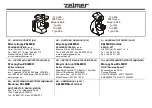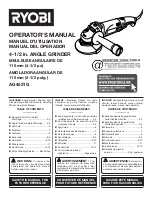
17
8. Specific instructions for the safe operation of grinding or cutting with abrasive disks
8.1. Use only provided for your abrasive grinding discs and used for abrasive disc guard.
Abrasive disks are not designed for grinding may not be well shielded and do not guarantee
safe operation.
8.2. Guard must be securely attached to grinders and be located so as to ensure maximum
safety, for example abrasive disk should not be covered by a mantle directed to working with
the machine. Housing should prevent the machine from working with scatter to dislodge
pieces from coming into contact with the rotating abrasive disk.
8.3. The use of abrasive discs only for the purposes for which they are provided. For
example: never grind with the side of a disc cutting. Cutting discs are designed for removing
material with its edge. Lateral application of force can break them.
8.4. Always use a retainer nut (8), which are in impeccable condition and correspond in size
and shape of the used abrasive disk. Locking nuts (8) for the blades may differ from those
discs for grinding. In some models, locking nuts (8) can be used for and drives for grinding,
having screwed on the reverse side with the projecting part of the disc.
8.5. Do not use abrasive discs worn by larger grinders. Discs for older machines are not
designed for high-speed rotation, which rotate in small and can break.
9. Specific instructions for safe handling of blades.
9.1. Avoid blocking the cutting disk or pinched him strong. Not perform very deep
cuts. Overloading of the cutting disc increases the risk of wedge or blocks it, and thus the
occurrence of recoil or fracture while spinning.
9.2. Avoid the area will be in front of and behind the rotating cutting disc. When cutting disc
is in a plane with your body in case of recoil angle grinder with the rotating disk can bounce
directly to you and hurt you.
9.3. If the cutting disk when block or interrupting work grinding off and leave it until after
the final stop of the rotation of the disc. Never attempt to remove the turntable from the cutting
channel, otherwise the recoil may occur. Identify and remove the cause of the wedge.
9.4. Do not switch the angle grinder again if the disc is cut in detail. Be carefully before
you continue cutting, cutting disc to wait up to full speed. Otherwise, the disc cans block to
rebound from the work piece or cause recoil.
9.5. Provide a stable attachment of large parts in an appropriate way to limit the risk of
recoil jammed as a result of cutting disc. During cutting large parts can be bent into action
under its own weight.
9.6. Be especially cautious in cutting channels in walls or other areas that can conceal
surprises. Cutting disc can cause the machine to kick to touch or gas pipelines, power lines
or other objects.
10. Specific instructions for safe operation in grinding with sandpaper.
10.1. Do not use too large sheets of sandpaper, follow the manufacturer’s instructions for
the size of sandpaper.
10.2. Sandpaper sheets to be made outside the receiving disk can cause injury and lead to
blockage and rupture of sandpaper or the occurrence of recoil.
11. Specific instructions for the safe operation of cleaning with wire brushes.
11.1. Do not forget that in the normal operation of the wire brush fall staples. Do not
overload the wire brush by squeezing it too hard. Scatter wire brush from staples can easily
penetrate clothing and / or skin.
11.2. Prior to make sure that the wire brush is not touching the guard. Cupped disc and wire
brushes can increase its diameter due to the power of jamming and centrifugal forces.
12. Additional instructions for safe operation.
Work with goggles.
12.1. Use appropriate instruments to find any hidden beneath the surface pipelines, or
contact the appropriate local supply company. Into contact with the wires under tension can
cause fire or electric shock. Pipeline damage can lead to explosion. Deterioration of water has
the effect of major material damage and may cause electric shock.
















































